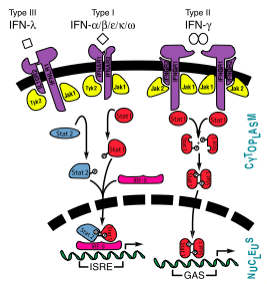Interferon
From Proteopedia
| Line 1: | Line 1: | ||
| - | [[Image:InterferonSignalingPathway.png|525px|right|thumb|Interferon Pathway<ref>[http://www.jbc.org/content/282/28/20045.full?sid=cbf08059-44d4-4957-8ea7-0351cab9c2ac] Samuel, C.E. "Interferons, Interferon Receptors, Signal Transducer and Transcriptional Activators, and Inteferon Regulatory Factors." ''J Biol Chem'' 2007 282: 20045-20046. First Published on May 14, 2007, doi:10.1074/jbc.R700025200</ref>]] | + | [[Image:InterferonSignalingPathway.png|525px|right|thumb|Interferon Pathway<ref name="Isaacs">[http://www.jbc.org/content/282/28/20045.full?sid=cbf08059-44d4-4957-8ea7-0351cab9c2ac] Samuel, C.E. "Interferons, Interferon Receptors, Signal Transducer and Transcriptional Activators, and Inteferon Regulatory Factors." ''J Biol Chem'' 2007 282: 20045-20046. First Published on May 14, 2007, doi:10.1074/jbc.R700025200</ref>]] |
| + | '''Interferons''' were the first cytokines discovered and were identified by Isaacs and Lindenmann. These proteins were identified as interferons because they interfered with virus growth.<ref name="Isaacs" /> The initial experiments performed poorly characterized the interferons, and was based merely on bioactivity. Advances in scientific instrumentation and technique have allowed for greater understanding and visualization of not only the structure but also the mechanisms of the various types of inteferons.<ref name="Structure">PMID:2413490</ref> | ||
| - | + | The interferons were originally classified as leukocyte (interferon-α), fibroblast (interferon-β), and immmune (interferon-γ), although today they are classified into types I (α and β) and II (γ). This classification serves to give a better understanding of the similarities between α and β that does not exist between these type I interferons and interferon-γ.<ref name="Structure" /> In addition to interferons-α and -β, type I interferons also encompass three other differentiable proteins: interferon-ε, interferon-κ, and interferon-ω. | |
{{Clear}} | {{Clear}} | ||
Revision as of 23:59, 23 April 2012

Interferons were the first cytokines discovered and were identified by Isaacs and Lindenmann. These proteins were identified as interferons because they interfered with virus growth.[1] The initial experiments performed poorly characterized the interferons, and was based merely on bioactivity. Advances in scientific instrumentation and technique have allowed for greater understanding and visualization of not only the structure but also the mechanisms of the various types of inteferons.[2]
The interferons were originally classified as leukocyte (interferon-α), fibroblast (interferon-β), and immmune (interferon-γ), although today they are classified into types I (α and β) and II (γ). This classification serves to give a better understanding of the similarities between α and β that does not exist between these type I interferons and interferon-γ.[2] In addition to interferons-α and -β, type I interferons also encompass three other differentiable proteins: interferon-ε, interferon-κ, and interferon-ω.
| |||||||||||
A comparative representation of three interferons
|
|
|
Synchronize the three applets showing interferons alpha, beta, and gamma by clicking the checkbox
Proteopedia Page Contributors and Editors (what is this?)
Michal Harel, Kirsten Eldredge, Alexander Berchansky, Joel L. Sussman, Karl Oberholser, Jaime Prilusky
